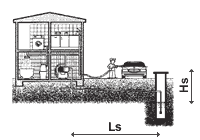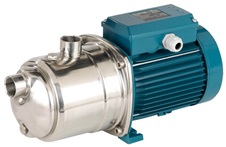We are acquiring a pump
Learn about pump types, find out what you need to know before you go shopping and what to watch out for.
Each type of pump is designed for a specific purpose. Wrong choice can achieve not only uneconomical operation, but in the worst case we can irretrievably damage the pump and then necessarily seek replacement, which will become more expensive. The right type of pump with the corresponding properties needs to be able to choose and the time we devote to it pays off thanks to its reliable operation in the future.
What is a pump anyway?
The pump is a unit composed of a drive unit and its own pump, which imparts motion energy to water. Pumps are used to transport water. The mode of transport is either suction or displacement.
What do we need to know before we go buy a pump?
Before we start to select the pump, we need to know the answer to 4 fundamental questions about its future operation.
- What kind of water do we want to pump?
- Where do we want to pump water from?
- How often do we want to pump it?
- How much do we want to pump?
- What to be careful of
What kind of water do we want to pump
Before we decide to buy a pump, we must first clarify which water we will pump - whether drinking water, clean utility water, rainwater or sewage water. If we want to pump water from sources other than underground, we have to choose the pump according to the degree of pollution.
- CLEAN UTILITY WATER - pumping river, rainwater or pond water does not require a special pump design, but it is necessary to prevent the entry of dirt such as leaves, grass, etc. into the pump by suitable suction baskets. In this case, the suction basket must have a very fine grid. In the case of so-called sludge pumps designed for pumping slightly polluted water, the suction side is equipped with a grid that releases only such large impurities that pass through the pump at the same time as the pumped liquid. Under no circumstances may these pumps be used for the pumping of sewage.
- SEWAGE water - pumps used for sewage pumping are mainly cast iron, stainless steel and construction adapted primarily to the shape of the impeller. In many cases, it is necessary to use a pump with acutting device that first crushes the coarse impurities and then exhausts them.
- A separate chapter is the so-called construction sludge pumps resistant to sand.
Where do we want to pump water from
Another thing we need to know is where we want to pump water from. Whether it is river or pond water, a borehole or a well, how deep the water is and how far the water source is.
- Surface pumps can only draw water from a depth of 8m. From greater depths, we must use a submersible pump. From a technical point of view, therefore, the water source is decisive. If the height between the intake and the water level is less than 8m, including losses in the horizontal part of the intake manifold, we choose a water plant with a pump on the surface, otherwise a water plant with a pump in a well or borehole. A submersible pump can almost always be used. It is more expensive, but it has certain advantages.
- The height difference in water is one of the variables important for calculating pump power. We have to add all heights from the water source to the outlet and add the loss of 1 m in height for every 10 m of pipe length. At the same time, it is necessary to be able to convert to meters another quantity: 10 m height corresponds to 1 Atm, 100 J/kg, 0,1 Mpa.
- To determine the required water pressure (MPa) at the place of consumption, it is necessary to know the location and types of appliances: automatic washing machine, dishwasher, etc.
- If we want to pump water from a river or stream, the distance of our land from the water source can be a decisive factor, because the technical parameters of the pump do not have to play the most important role here, but security against theft. In this case, it is better to use the surface pump on your own plot than submersible at the water source.

(Hs) level (from pump neck to lowest water level)
(Ls) distance of the well from the intended location of the waterworks
How often do we want to pump it
Do you need a pump for occasional use e.g. in the garden or permanently in a family house? Possibly deployed 24 hours a day?
- Plastic pumps are recommended for occasional use. Stainless steel pumps are recommended for permanent use.
- If we want to supply the property with water, we must use domestic waterworks.
- Part of the domestic waterworks is a pressure vessel, nowadays mostly membrane, which prevents frequent switching of the pump.
- Compact automatic machines (no need to purchase pressure vessels, pressure switch and other components) will be used in areas with a lack of space. The advantage of compact water plants is automatic operation - the pump starts only when water is consumed.
- The output of the domestic waterworks is always determined by the output of the pump and not by the size of the vessel, which affects the frequency of switching the pump.
- The size of the container can therefore be derived from the water consumption data - it is advisable to leave the overall assembly to the expert.
How to avoid pressure fluctuations?
Domestic water plants with a frequency inverter that permanently senses the pressure in the system and changes the pump speed depending on the current water flow are suitable for objects with variable water consumption but the need to maintain a constant pressure.
How much do we want to pump
Another important indicator for the purchase of the pump is the amount of water (flow) that we want to pump, marked with the letter Q, the units arel/s, l/min., m³/h. There are two indicators for determining the amount of water, the number of people and the spectrum of water use. In particular, the second indicator is currently important for swimming pools, saunas, dishwashers and large gardens.
For this reason, the demand for immediate consumption of water has increased in the last few years, especially in family houses. For the supply of such a house, a power of about 3m³/hour with sufficient pressure is required.
Pumps up to 2,000 liters per hour should be sufficient for garden watering and similar occasions.
A few tips and tricks to close
- If you want to use the pump for three-phase current, check its availability at the place of use.
- If the well or borehole yield is less than the pump output, installation of a level monitor is required.
- Buying a pump without a secure service is a gamble.
- Do not reduce the diameter of the discharge pipe or hose to achieve the parameters indicated on the pump.
- Beware of the indicated pump parameters. Often, only data determining the maximum values of the amount of water and displacement pumped (Qmax and Hmax) are given.

